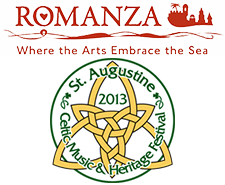3rd St Augustine Celtic Music and Heritage Festival

The incongruity of Buccaneers, Pipes, Palm Trees and the flags of the Celtic Nations was difficult to dismiss whilst Transceltic attended the 3rd Annual St. Augustine Celtic Music and Heritage Festival held in this beautiful Florida City which dates from 1565. The British, under Oliver Cromwell, captured Jamaica in 1655 and 13 years later Jamaica served as the base for a devastating attack on St. Augustine. It was in response the rapine pillage of 1668 that led to the construction of the magnificent fortress that today guards the waterfront. This is a mystic ancient place benefiting from a compact walkable town centre which is reminiscent of the New Orleans French Quarter or Quebec City. Saint Augustine is the oldest permanently occupied European settlement in the United States, a genteel, cosmopolitan and above all a welcoming and secure environment of dazzling beauty. It is somewhat shocking to exit the infamous Interstate 95 and travel 15 minutes through a busy commercial corridor of malls, coffee shops and car dealerships to cross a bridge and enter into the 17th century.
The Festival, with two Stages for live entertainment and an expanse of exhibitors housed in lanes of tents with an adjacent "Scottish Amateur Highland Games" would have been a boisterous robust event even if it had not had a popular Beer Tent. The Festival’s founder is John Meehan, a native of Ireland, Publican and newcomer to Saint Augustine who was the driving force in the inaugural Festival held in 2011. This years’ Event Coordinator, John Cunningham, estimates that attendance has increased from 2,500 attendees at the Festival’s first year to an estimated 20, 000 in 2013. This dramatic increase is no doubt a function of this City’s allures but also reflects the Celtic Renaissance that has taken a firm hold in North America with festivals of this type multiplying and growing throughout the Unites States and Canadian Provinces.
This year's two day festival began with the obligatory Saint Patrick’s Day Parade, comprised of a somewhat unusual mix of local Marching Bands, Pipers, Belly Dancers, Pirates, a charming local dance troupe associated with the Irish Academy of Dance "Gor na Daire" and a surreal company of Imperial Starship Troopers in Kilts. The parade route was along the city’s centuries old Quay which is dominated by the 1672 fortress "Castillo de San Marcos". The Parade ended at the festival venue, Francis Field, where continuous entertainment was provided by Celtic bands including the renowned Ireland based “Dublin City Ramblers” (Ireland’s 2012 Ballad/Folk Group of the Year) and the legendary "Tannahill Weavers" from Paisley, Scotland. Also performing were the band "Rathkeltair", a Florida based band with Irish, America, Canadian and English members and the premiere act of the Festival, the Scottish band "Albannach". Ardent Albannach fans no doubt contributed significantly to the Festival’s record attendance.
Vendors touting Celtic themed retail items lined the avenues within the festival grounds which lent a carnival like atmosphere. Inquiries of the retailers disclosed that they form a tightly knit community some of whom travel from festival to festival during the year, with Irish, Scottish and Welsh accents amongst the proprietors of the retail tents. In addition, representatives of many Scottish Clans and Celtic Organizations maintain a presence at these Festivals and amongst the exhibitors were Clan Sutherland of North America, Clan Campbell, The American Gaelic Society and the New World Celts. The New World Celts are active supporters of all things Celtic and provided volunteer staff for the running of the festival.
The Saint Augustine festival stands apart from the mainstream in its acknowledgement of Asturias as a Celtic Nation, which goes against the consensus position of the Celtic League, the principal organization of the Pan Celtic movement. And indeed there was an Asturian flag forming the backdrop of the stage along with the flags of the Six Celtic nations. This is understandable given the context of the city's founding. Saint Augustine’s founder is Pedro Menendez di Aviles who takes his name from the city of Aviles which is a major urban centre in the Spanish province of Asturias. The city of Aviles annually plays host to the well known “Aviles InterCeltic Festival”.
We wish to express our appreciation to the St. Augustine, Ponte Vedra & The Beaches Visitors and Convention Bureau for their hospitality. With special thanks to our gracious and lovely host, Barbara Golden, who took the time to introduce us to this bewitching city.
Other articles of interest
External links
- Pan-Celtic
- English






